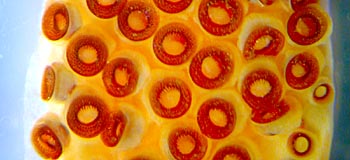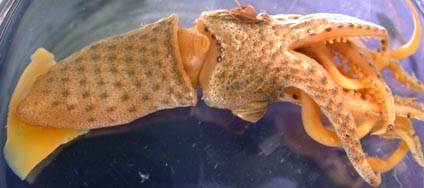Histioteuthis sp. A
Richard E. Young and Michael VecchioneIntroduction
This is a rather cyclindrical, muscular histioteuthid that is known only from five squid captured in the waters around the Hawaiian Islands.
Brief diagnosis:
A Histioteuthis ...- with a single sawtooth in Basal Row of photophores.
- with virtually symmetrical outer sucker rings in ventromarginal series on club manus.
Characteristics
- Tentacles
- Central suckers just slightly enlarged over marginal suckers.
- Suckers of ventral-marginal rows of manus with broad, but nearly symmetrical outer rings.
 Click on an image to view larger version & data in a new window
Click on an image to view larger version & data in a new window

Figure. Left - Oral view of a swath across the manus of the club of Histioteuthis sp. A, 41 mm ML, Hawaii. The small suckers on the right are carpal suckers. Right - Oral view of a ventral-marginal sucker of the club, 41 mm ML, Hawaii. Photographs by R. Young.
- Medial manal suckers of club with slender teeth only on distal margin of inner ring; proximal margin with small teeth difficult to see under dissecting microscope.
Figure. Oral view of large, central manus suckers of the club of Histioteuthis sp. A, 41 mm ML,Hawaii.Photograph by R. Young.
Scanning electron micrographs of the arms and club suckers can be seen here.
- Head
- Photophores: Basal Row comprised of 9 photophores, and forms distinct sawtooth at left end.
Figure.Ventral view of posterior edge of head of Histioteuthis sp. A showing the Basal Row, 41 mm ML, Hawaii. Photograph by R. Young.
- Beaks: Descriptions can be found here: Lower beak; upper beak.
- Photophores: Basal Row comprised of 9 photophores, and forms distinct sawtooth at left end.
Comments
More details of the description can be found here.Species of the celetaria-group are characterized by:
- Head and arm photophores:
- Type 1b pattern on head.
- Basal Row of head with 9 or 10 photophores.
- Right Basal Series of head absent.
- Arms IV with 3 longitudinal series on arm base (drawing below).
- Most species with separate group of 4-8 compound photophores on ends of arms IV (drawing above) (Voss, et al., 1998). Apparently this feature is absent in H. inermis.
- Compound photophores of large, uniform size and evenly spaced on anterior 2/3 of ventral mantle.
- Tubercles
- Absent.
The species differ in the following manner:
| Character | H. celetaria | H. inermis | H. pacifica | H. sp. A |
| Club suckers | ||||
| Asymmetrical outer sucker rings in: | 3 ventral-marginal sucker series | No asymmetrical rings | 2 ventral-marginal sucker series | No asymmetrical rings |
| Size of medial manal suckers: | Slightly larger than marginal suckers | 2 X marginal suckers | 1.5 X marginal suckers | Slightly larger than marginal suckers |
| Large manal-sucker dentition: | 12-13 teeth on distal margin | 20-27 teeth on entire margin | 28-32 teeth on entire margin | 15-20 teeth on distal margin |
| Photophores | ||||
| Single sawtooth in Basal Row photophore pattern: | Yes | No sawtooth | No sawtooth | Yes |
| Number of photophores in Basal Row: | 9 | 10 | 9 | 9 |
With the exception of the analysis of head photophores and the inclusion of H. inermis in this species group, most of the information presented in this table is from Voss (1969) and Voss, et al . (1998)
References
Voss, N. A. 1969. A monograph of the Cephalopoda of the North Atlantic: The family Histioteuthidae. Bull. Mar. Sci., 19: 713-867.
Voss, N.A., K. N. Nesis, P. G. Rodhouse. 1998. The cephalopod family Histioteuthidae (Oegopsida): Systematics, biology, and biogeography. Smithson. Contr. Zool., 586(2): 293-372.
Title Illustrations

| Scientific Name | Histioteuthis sp. A |
|---|---|
| Comments | Ventral view, 25 mm ML, Hawaiian waters, preserved. Photograph. |
| Image Use |
 This media file is licensed under the Creative Commons Attribution-NonCommercial License - Version 3.0. This media file is licensed under the Creative Commons Attribution-NonCommercial License - Version 3.0.
|
| Copyright |
© 2003

|
About This Page
Drawing from Voss (1969) printed with the Permission of the Bulletin of Marine Science.

University of Hawaii, Honolulu, HI, USA

National Museum of Natural History, Washington, D. C. , USA
Page copyright © 2013 and
 Page: Tree of Life
Histioteuthis sp. A .
Authored by
Richard E. Young and Michael Vecchione.
The TEXT of this page is licensed under the
Creative Commons Attribution-NonCommercial License - Version 3.0. Note that images and other media
featured on this page are each governed by their own license, and they may or may not be available
for reuse. Click on an image or a media link to access the media data window, which provides the
relevant licensing information. For the general terms and conditions of ToL material reuse and
redistribution, please see the Tree of Life Copyright
Policies.
Page: Tree of Life
Histioteuthis sp. A .
Authored by
Richard E. Young and Michael Vecchione.
The TEXT of this page is licensed under the
Creative Commons Attribution-NonCommercial License - Version 3.0. Note that images and other media
featured on this page are each governed by their own license, and they may or may not be available
for reuse. Click on an image or a media link to access the media data window, which provides the
relevant licensing information. For the general terms and conditions of ToL material reuse and
redistribution, please see the Tree of Life Copyright
Policies.
- Content changed 15 August 2010
Citing this page:
Young, Richard E. and Michael Vecchione. 2010. Histioteuthis sp. A . Version 15 August 2010 (under construction). http://tolweb.org/Histioteuthis_sp._A/19797/2010.08.15 in The Tree of Life Web Project, http://tolweb.org/











 Go to quick links
Go to quick search
Go to navigation for this section of the ToL site
Go to detailed links for the ToL site
Go to quick links
Go to quick search
Go to navigation for this section of the ToL site
Go to detailed links for the ToL site